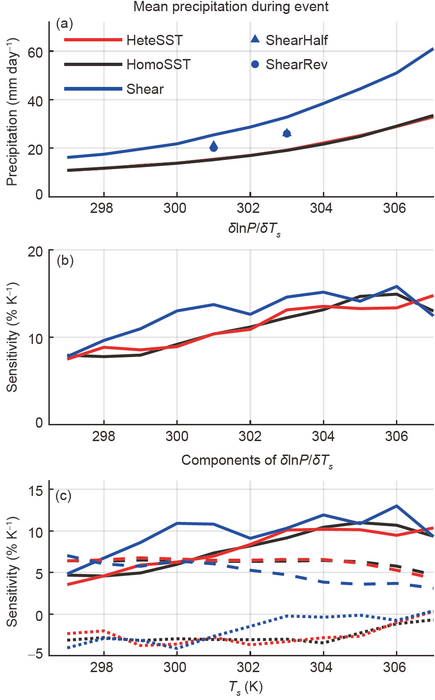Reviewed by Alex SmithNov 14 2022
This study has been headed by Dr Ji Nie (Assistant Professor at the Department of Atmospheric and Oceanic Sciences, Peking University).

The blue triangles and filled circles in (a) denote the simulations of weak shear and reversed shear (ShearHalf and ShearRev, 301 K and 303 K runs). (c) shows the dynamic (solid lines) and thermodynamic (dashed lines) components of the sensitivity. The dotted lines in (c) indicate the residual term (which also may be interpreted as the precipitation efficiency term). In (a)–(c), the black, red, and blue colors denote the experiments in the HomoSST, HeteSST, and Shear groups, respectively. Image Credit: ©Science China Press
The research group cooperates with other scientists in utilizing a conditional storyline attribution technique depending on a column quasi-geostrophic modeling framework. The outcomes display that warming during the last century has considerably strengthened the extreme precipitation event.
Since the role of convective organization, shear-organized convection assisted considerably in the extreme precipitation on both station and regional scales.
As climate change wakes up extensive worry, people question how does climate change impact this type of extreme event? The plot line attribution technique is utilized here to evade dealing with the doubtful nature of large-scale dynamics linked to extreme events under climate change.
It is more preferable to view the circulation regime linked to the event as unaltered with climate warming and see how the variations in thermodynamic states (like temperature, sea surface, and water vapor) impact the specific event.
A column quasi-geostrophic (CQG) framework relying on the quasi-geostrophic omega equation has been initiated to socially feign the large-scale dynamics. This framework enables scientists to determine the large-scale forcing linked to the synoptic regime and simulate the interaction happening between large-scale and convective dynamics.
Three groups of experiments have been developed to analyze the effects of various convective organizations. Having been pushed by uniform surface temperature, heterogeneous surface temperature, and background low-level wind shear, the three groups of experiments display organized clustered, disorganized convection, and squall-line convection correspondingly.
As far as every group is concerned, the large-scale forcing (vorticity and temperature advection) has been prescribed and surface temperature is increased to depict climate warming.
The outcomes display that global warming contributed considerably to the intensification of the “21·7” Henan extreme precipitation event. The cloud-resolving simulations that have been coupled with the CQG method tend to capture the extreme event fairly well.
It is displayed that moistening and warming of the air headed to reinforced regional-scale (10–14% K-1, based on the convective organization) and station-scale precipitation extremes (7–9% K-1).
When taking the regional-scale precipitation into account, the shear-organized convection seems to be much more sensitive to large-scale forcing and results in much greater precipitation than the other two groups. Also, the shear-organized convection consists of a bigger sensitivity to warming as a result of its powerful diabatic heating feedback.
When station-scale precipitation is concerned, the shear-organized convection also produces much bigger chances of extreme precipitation. No systematic dependence has been noted on the convective organization for the climate sensitivity of station-scale extreme precipitation.
The innovative CQG method enables scientists to handle large-scale forcing and convective organizations with resilience.
This work performed clearly denotes the significance of mesoscale convective organization in linking convective- and large-scale dynamics. Furthermore, this study takes one-step progress in fulfilling the station-scale precipitation extremes in a real extreme weather event.
Journal Reference:
Qin, H., et al. (2022) Climate change attribution of the 2021 Henan extreme precipitation: Impacts of convective organization. Science China Earth Sciences. doi.org/10.1007/s11430-022-9953-0.